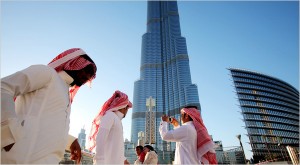By Michael Slackman www.nytimes.com
DUBAI, United Arab Emirates — In the first three days after Dubai opened the tallest building in the world, about 10,600 people paid a total of more than $280,000 to ride an elevator to the observation deck on the 124th floor. Outside, day after day, revelers jockeyed for position to be photographed standing before the shimmering tower that reaches 2,717 feet straight up into the steely blue sky.

Many in the crowd said they were so awestruck by the sheer audacity of what Dubai had accomplished with the building, the Burj Khalifa, that they were convinced that this brassy sliver of outsized ambition in the Persian Gulf would continue to command envy and investment despite Dubai’s spectacular and humbling financial stumble.
“This shows how the wealth is moving from the West to the East,” said Prajash Kelkar, who has lived in Dubai for 11 years and said he has no worries about the financial situation. “It’s the pride of Dubai.”
There is no question that Dubai’s leaders are practiced in the alchemy of image. With all their recent troubles, they focused on completing this one “iconic” project, as they like to call it. But with an estimated $100 billion in debt, a burst real estate bubble, disillusioned investors, a skyline defined not by one tall building but by a host of unfinished buildings, is that enough?
The answer many be found nearby in International City, one of Dubai’s less heralded but no less brazen projects. It stands now as an example of what happens when a housing market collapses, rents drop and those responsible for maintenance and services are short on cash and deep in debt.
The 2,000-acre development, which aspired to “become the business and cultural hub of the Middle East,” according to its Web site, has fallen far short of that. Traffic circles are now overgrown. Apartment buildings are almost completely vacant. Rows of storefronts are empty.
Families say they feel stuck, unable to sell and frightened for their safety. There are reports of crime, and what was supposed to be a family neighborhood has been transformed into a place where companies house low-wage laborers.
There are piles of construction debris, a flooded parking lot and street lights that do not work. A nearby sewage treatment plant emits waves of foul fumes. While no one has predicted that Dubai will become one vast International City, financial analysts said that International City’s problems did seem to represent the direction of things to come.
Mammoth developments, like the Dubai Mall, with its shark-filled aquarium, ice skating rink, decorative fountain, a 22-screen movie theater and miles and miles of stores, need lots of people spending lots of money to finance the developments’ debts. But those people, so plentiful in years past, are disappearing.
In International City, “Lots of people have already left,” said Raj Kuwar, owner of Sky Market Grocery. Mr. Kuwar said that his business was down 30 percent from last year but that another kind of business, prostitution, appeared to be up.
“Those girls have moved to this area now, because the rents are cheaper,” he said.
The complex of apartment buildings was developed by Nakheel, the troubled arm of the government-owned conglomerate called Dubai World. It was Nakheel that built the Palm Jumeirah, an island shaped like a palm tree and packed tight with apartment buildings and villas. It was also Nakheel’s decision to stop paying interest on its $26 billion debt that first revealed the depth of Dubai’s financial problems.
Today, whole blocks of buildings at the Palm are dark, and appear empty.
But the Palm, at least for now, manages to retain an image of privilege and status. Not so International City.
Bassam Saade lives in one of the buildings there with his wife, Charlie, and their son, Fawzi. On his son’s first birthday this month, he decorated his front door with balloons, though there was virtually no one to share the celebration with. He said that of 44 apartments in his building, only 6 remained occupied.
Mr. Saade said that the building’s janitor no longer used cleaning fluid, only water, that the lock on the entrance door had been broken for a long time and that there was very little other maintenance. He said he would not open the windows because of the stench from the sewage plant.
The one good point, he said, was that he no longer had trouble finding parking.
If there is hope for Dubai, financial analysts said, it is in Abu Dhabi, the emirate that serves as the capital of the United Arab Emirates and sits on a large pool of oil. The emir of Abu Dhabi, Sheik Khalifa bin Zayed al-Nahyan, has already come to the rescue with $10 billion to pay immediate debts and forestall a financial collapse. But that may just forestall the inevitable. “The image of course will probably fade; it will not be as it used to be,” said Amer al-Tameemi, an economic analyst from Kuwait.
But perhaps not. Dubai’s leaders learned long ago the value of image, of how large shiny objects inspire confidence. And it seemed to be working again, here in the shadow of the Burj Khalifa.
There seemed a collective case of tunnel vision. No one saw — or at least spoke of — the stilled cranes bordering the tower. “I have not lost even 1 percent of my confidence in Dubai,” said Mohana Kelkar after her husband, Prajash, took her picture.
Ahmed Khalifa and his friend, Sultan Obeidy, joined the crowds, too. They both said that the building was great, but that even more important was the scene around them, where people from all over the world gathered in one place, free to celebrate together.
“Dubai’s success comes from risk-taking,” Mr. Khalifa said. “That won’t change.”













